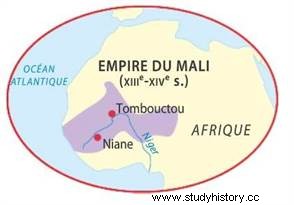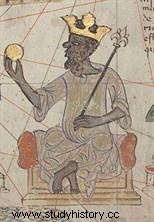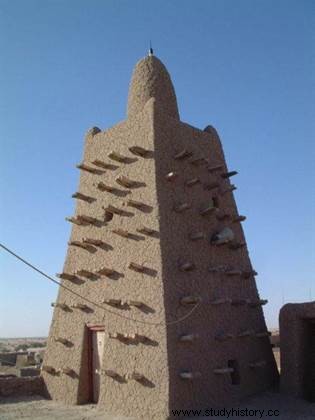 The Mali Empire was the first of the great Muslim empires of West Africa, which controlled this region from the 13th to the beginning of the 15th century. Founded by the legendary Soundiata Keita, this new entity quickly became a rich and powerful state, connected to the commercial and cultural networks of Africa, well beyond the Sahara, to the Muslim world. In the 14th century, the reputation of Mansa even crossed the Mediterranean as it was featured on the famous Catalan Atlas , offered to the King of France Charles V by the King of Aragon. The Empire of Mali disintegrated from the 15th century with the emergence of the kingdom of Gao, better placed for commercial relations with the Arab world, and from which was born the Songhai Empire.
The Mali Empire was the first of the great Muslim empires of West Africa, which controlled this region from the 13th to the beginning of the 15th century. Founded by the legendary Soundiata Keita, this new entity quickly became a rich and powerful state, connected to the commercial and cultural networks of Africa, well beyond the Sahara, to the Muslim world. In the 14th century, the reputation of Mansa even crossed the Mediterranean as it was featured on the famous Catalan Atlas , offered to the King of France Charles V by the King of Aragon. The Empire of Mali disintegrated from the 15th century with the emergence of the kingdom of Gao, better placed for commercial relations with the Arab world, and from which was born the Songhai Empire.
The founding of the Empire of Mali
A mixture of oral traditions and late written sources or from the Muslim world, the founding of the Empire of Mali is linked to the largely legendary epic of Soundiata Keita.
 The versions being numerous and differing in certain aspects, it is difficult to describe one how Keita founded the Mali Empire. We can nevertheless say that the Manden (or Manding), heart of the future Mandinka empire, and located today between Guinea and Mali, would have been attacked by the king of Soso, Sumaworo. The latter would have defeated Dankara Tuman, whose half-brother, Soundiata Keita, had been exiled.
The versions being numerous and differing in certain aspects, it is difficult to describe one how Keita founded the Mali Empire. We can nevertheless say that the Manden (or Manding), heart of the future Mandinka empire, and located today between Guinea and Mali, would have been attacked by the king of Soso, Sumaworo. The latter would have defeated Dankara Tuman, whose half-brother, Soundiata Keita, had been exiled.
The people of Manden are said to have called on Keita for help, around the 1230s. After several battles, the king of Soso was defeated, and Keita, who gathered most of the clans of the region, becomes "Mansa". He reigned until 1255 and set up a solid administration. Centralized and prosperous thanks to its gold resources, the Mali Empire then dominated West Africa (where it massively spread Islam) until the 15th century.
The capital and the court of Mansa
The capital of the Mali Empire was probably Niani, on the Sankarani, in the northeast of present-day Guinea. It was visited by the traveler from Tangiers Ibn Battuta in 1353. Admitted to the court, he admired "the magnificent gold and silver quivers of the squires, sabers adorned with gold and whose scabbards (were) in gold, spears in gold and silver [...] the beautiful clothes of women wearing headbands of gold and silver, trimmed with golden apples”.
It is mainly thanks to the Muslim traveler Ibn Battûta that we know the functioning of the court of the Emperor of Mali (whom he calls "sultan") in the 14th century. He describes it as sumptuous, with the presence of both ministers and soldiers, governors, and semi-independent vassals. Ibn Battûta insists on the display of wealth that characterizes this court. Rare products, such as velvet and silk, but above all gold, lots of gold. Indeed, if the population lived mainly from agriculture, the State drew its great wealth from the exploitation of gold and the trans-Saharan trade, in particular slavery.
Kanga Moussa's pilgrimage to Mecca
As famous, if not more, than Soundiata Keita, the Mansa Kanga Moussa became famous in the 14th century. It is he who is represented on the Catalan Atlas, like a Western monarch, seated on a throne, crowned, a specter in his hand, and holding a gold-colored sphere in the other hand.
 For contemporaries, Kanga Moussa was known for his great pilgrimage to Mecca, made between 1324 and 1326. Accompanied thousands of soldiers, part of his court, and a gigantic caravan full of gold (we are talking about several tons), the emperor stopped every Good Friday in a city or a village and built there a mosque. He would have spent so much gold that he would have caused the price to fall, and would have finally had to borrow from an Egyptian who arrived in Cairo! This did not prevent the emperor, on his return, from building large mosques in Gao and Timbuktu, and a palace in Niani, described by Ibn Battûta.
For contemporaries, Kanga Moussa was known for his great pilgrimage to Mecca, made between 1324 and 1326. Accompanied thousands of soldiers, part of his court, and a gigantic caravan full of gold (we are talking about several tons), the emperor stopped every Good Friday in a city or a village and built there a mosque. He would have spent so much gold that he would have caused the price to fall, and would have finally had to borrow from an Egyptian who arrived in Cairo! This did not prevent the emperor, on his return, from building large mosques in Gao and Timbuktu, and a palace in Niani, described by Ibn Battûta.
From the Mali Empire to the Songhai Empire
The reign of Kanga Moussa constitutes both the apogee and the decline of the Mali Empire. When he died in 1337 (the date is in dispute), the coffers were empty.
During the 14th century, even if the empire was in contact with its neighbours, notably Morocco (Kanga Moussa would have sent, according to Ibn Khaldûn, an emissary to the Moroccan sultan following at the capture of Tlemcen), the weakening is accelerating, particularly its influence on big business. Mali finds itself under the threat of the Tuaregs, and ends up yielding under the blows of the Songhaï.
 The latter, from the bend of the Niger, founded an empire in the 15th century that would have nothing to envy to the power of the Mali Empire, even if it in turn collapsed at the end of the 16th century.
The latter, from the bend of the Niger, founded an empire in the 15th century that would have nothing to envy to the power of the Mali Empire, even if it in turn collapsed at the end of the 16th century.
Bibliography :
- F. Simonis, Sudanese Africa in the Middle Ages. The time of the great empires (Ghana, Mali, Songhaï), Sceren, 2010.
- P. Boilley, JP. Christian, History of ancient Africa, 8th-16th century, Photographic documentation, 2010.
